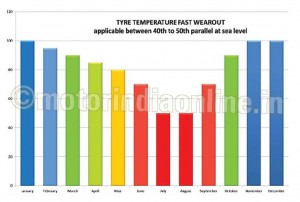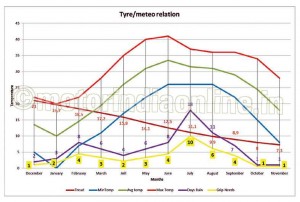
Tyre management plays a big role in fleet cost reduction as much as proper maintenance. Proper selection of types, tread designs, positions and fitting period are crucial for getting the final results. There are no magical formulas that can be applied for tyre selection.
Further it is not said that if you select a brand for a certain position the same brand should be fitted in all vehicle(s) positions. Nor is it said that the product delivering more miles is the right product, as in many cases new tyre positions are casing generators for retreading positions. Since casing is becoming scarce and costly, you need to balance the use of new and retreaded tyres selecting sometimes wearing faster new tyres in order to generate more casings.
But when you have properly chosen the right tyres for the right position, the next step is the ideal period of the year to fit your selected tyres on the vehicles.
You might think that you are forced to fit a new set of full treaded tyres (I’m using this terminology because this applies to both new and retreading tyres) when the old ones have reached the projected pull point (minimum remaining tread to removal point). It is where part worn stock (PWS) plays a big role in tyre management. A tyre’s worst enemy, besides low pressure and overloading, is heating.
In the following table you can see the effect of temperature on tyre consumption. Naturally there isn’t one table that fits globally. For each set of latitude you have one since this is related to the difference in temperature between the summer and winter.
The table shows the loss in performance of a full treaded tyre due to the temperature. Naturally the higher the tread depth, the higher the tyre’s working temperature that in summer goes above 100 Celsius. This as a result of higher rolling resistance.
 Tire rolling resistance gradually drops by about 20 per cent during the life of a tire as the tread wears from its original molded depth to worn out. This can be attributed to the reduction in the tread mass and rubber squirm, as well as subtle hardening of the tread compound during years of service and exposure to the elements.
Tire rolling resistance gradually drops by about 20 per cent during the life of a tire as the tread wears from its original molded depth to worn out. This can be attributed to the reduction in the tread mass and rubber squirm, as well as subtle hardening of the tread compound during years of service and exposure to the elements.
For the above reason, fitting “full treaded” tyres during the hot season turns into in a big economic loss as tyres get worn much faster than during the cold season. In addition, the tyre pressure will increase due to the higher temperature producing uneven treadwear, mainly in the tyre-crown center, further reducing the tyre life and the possibility for retreading.
For instance, if a full treaded tyre like 21mm delivers 9.000 km per mm during the cool season, this can be reduced to 4.500 km during the hot season at least for the first 2 or 3 mm. As the tyre is worn out, rolling resistance diminishes as explained above, reducing the effect of faster wear-out.
Smart Tyre Lifecycle Management suggests maintenance stock in-house of used tyres to fit during the critical part of the year.
In order to generate your own PWS, it’s important to keep under control the fleet tread profile on a monthly basis and establish the “Ideal Replacing Month” which is calculated by overlapping the main parameters: temperature along the year, rainfall during the year, the grip needed, and the monthly tread consumption.
In the following example, I have taken the area of Punjab with a fleet having a tyre monthly consumption between 0,7 and 1,7 mm of tread.
 The three top lines show regional temperature along the year in Celsius (maximum average the red one, minimum average the blue one and daily average the green one). The purple line indicates raining days within each month, the yellow line is your need of grip in a scale from 1 (min) to 10 (max). (The more rain, the greater the grip)
The three top lines show regional temperature along the year in Celsius (maximum average the red one, minimum average the blue one and daily average the green one). The purple line indicates raining days within each month, the yellow line is your need of grip in a scale from 1 (min) to 10 (max). (The more rain, the greater the grip)
The dark red line is the tyre tread depth month after month rolling under the vehicles in mm
It’s quite simple doing this type of exercise up to the north. It’s getting a bit more complicated when you get closer to the Equator as the temperature won’t change a lot during the year
Looking to the temperatures, in our exercise, the worst months to fit full treaded tyres are from April to August. The temperature is really high!
In our study anyway we have a problem. As if we look to the curve of “rainfall”, the peak is in August coincident with very high temperature.
How to solve it? Based on my experience I would fit full-treaded tyres in December when the temperature is more reasonable allowing me anyway to have a decent remaining tread depth during the rainy season.
As you might have noticed in my study, tyres after one year cycle still have 7,3 mm, considering a pull point of 3 mm and considering that at this level tyres have (in our example) a consumption of around 0,7 mm month, could last for another 6 months, ready to be replaced in the worst period of the year.
Creating your stock of used tyres around 11 mm, the remaining tread depth will allow you to maximize the use of your tyre.